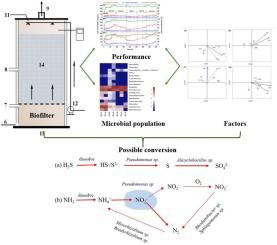当前位置:
X-MOL 学术
›
Process Saf. Environ. Prot.
›
论文详情
Our official English website, www.x-mol.net, welcomes your
feedback! (Note: you will need to create a separate account there.)
Factors impacting the performance and microbial populations of three biofilters for co-treatment of H2S and NH3 in a domestic waste landfill site
Process Safety and Environmental Protection ( IF 6.9 ) Pub Date : 2021-05-01 , DOI: 10.1016/j.psep.2020.11.009 Tianlong Zheng , Lin Li , Fengguang Chai , Yanjie Wang
Process Safety and Environmental Protection ( IF 6.9 ) Pub Date : 2021-05-01 , DOI: 10.1016/j.psep.2020.11.009 Tianlong Zheng , Lin Li , Fengguang Chai , Yanjie Wang

|
Abstract Numerous volatile organic compounds and odors are generated when municipal solid wastes decompose in landfill sites. Three biofilters (BF-1, BF-2, and BF-3) were deployed to remove H2S and NH3 accumulated under high density polyethylene films in a 30,000 m2 area landfill site in North China. Results showed that the inlet concentrations of H2S and NH3 were 16.4–220.3 mg/m3 and 2.0–56.4 mg/m3, respectively. Outlet concentrations were reduced to 1.0–33.1 mg/m3 for H2S and 0–9.2 mg/m3 for NH3. The H2S removal efficiencies were around 91.1 % for BF-1, 87.0 % for BF-2, and 82.6 % for BF-3 in a steady state. The respective removals of NH3 were 92.0 %, 89.3 %, and 81.1 %. Thus, H2S and NH3 were both treated effectively by the biofilters. The intake load presented a seasonal variation. A high elimination capacity was obtained in the biofilter harvesting high inlet load. High throughput sequencing technology was utilized to assay the microbial populations in the biofilters. Pseudomonas sp., Alicyclobacillus sp., Sphingomonas sp., and Rhodanobacter sp, which were linked to the degradation of H2S and NH3, were isolated and identified. Their characteristics and distributions in the biofilters depended on the inlet concentration of substrates and the microenvironment within the packing materials. The results from this bio-product analysis indicated that most of H2S was bio-oxidized into sulfur and sulfate while NH3 was converted into nitrate or dissolved into the liquid phase mainly by absorption or chemical neutralization in the biofilters.
中文翻译:

影响生活垃圾填埋场H2S和NH3协同处理的三种生物滤池性能和微生物数量的因素
摘要 城市固体废物在垃圾填埋场分解时会产生大量挥发性有机化合物和气味。三个生物过滤器(BF-1、BF-2 和 BF-3)用于去除华北 30,000 平方米垃圾填埋场高密度聚乙烯薄膜下积累的 H2S 和 NH3。结果表明,H2S 和 NH3 的入口浓度分别为 16.4-220.3 mg/m3 和 2.0-56.4 mg/m3。H2S 的出口浓度降低到 1.0–33.1 mg/m3,NH3 的出口浓度降低到 0–9.2 mg/m3。在稳定状态下,BF-1 的 H2S 去除效率约为 91.1%,BF-2 为 87.0%,BF-3 为 82.6%。NH3 的去除率分别为 92.0%、89.3% 和 81.1%。因此,H2S 和NH3 都被生物过滤器有效处理。摄入负荷呈现季节性变化。在收获高入口负载的生物过滤器中获得了高去除能力。高通量测序技术被用来分析生物过滤器中的微生物种群。分离并鉴定了与 H2S 和 NH3 降解有关的假单胞菌属、脂环酸杆菌属、鞘氨醇单胞菌属和红丹诺杆菌属。它们在生物过滤器中的特性和分布取决于基质的入口浓度和包装材料内的微环境。该生物产品分析的结果表明,大部分 H2S 被生物氧化为硫和硫酸盐,而 NH3 主要通过生物过滤器中的吸收或化学中和作用转化为硝酸盐或溶解到液相中。高通量测序技术被用来分析生物过滤器中的微生物种群。分离并鉴定了与 H2S 和 NH3 降解有关的假单胞菌属、脂环酸杆菌属、鞘氨醇单胞菌属和红丹诺杆菌属。它们在生物过滤器中的特性和分布取决于基质的入口浓度和包装材料内的微环境。该生物产品分析的结果表明,大部分 H2S 被生物氧化为硫和硫酸盐,而 NH3 主要通过生物过滤器中的吸收或化学中和作用转化为硝酸盐或溶解到液相中。高通量测序技术被用来分析生物过滤器中的微生物种群。分离并鉴定了与 H2S 和 NH3 降解有关的假单胞菌属、脂环酸杆菌属、鞘氨醇单胞菌属和红丹诺杆菌属。它们在生物过滤器中的特性和分布取决于基质的入口浓度和包装材料内的微环境。该生物产品分析的结果表明,大部分 H2S 被生物氧化为硫和硫酸盐,而 NH3 主要通过生物过滤器中的吸收或化学中和作用转化为硝酸盐或溶解到液相中。被隔离和鉴定。它们在生物过滤器中的特性和分布取决于基质的入口浓度和包装材料内的微环境。该生物产品分析的结果表明,大部分 H2S 被生物氧化为硫和硫酸盐,而 NH3 主要通过生物过滤器中的吸收或化学中和作用转化为硝酸盐或溶解到液相中。被隔离和鉴定。它们在生物过滤器中的特性和分布取决于基质的入口浓度和包装材料内的微环境。该生物产品分析的结果表明,大部分 H2S 被生物氧化为硫和硫酸盐,而 NH3 主要通过生物过滤器中的吸收或化学中和作用转化为硝酸盐或溶解到液相中。
更新日期:2021-05-01
中文翻译:

影响生活垃圾填埋场H2S和NH3协同处理的三种生物滤池性能和微生物数量的因素
摘要 城市固体废物在垃圾填埋场分解时会产生大量挥发性有机化合物和气味。三个生物过滤器(BF-1、BF-2 和 BF-3)用于去除华北 30,000 平方米垃圾填埋场高密度聚乙烯薄膜下积累的 H2S 和 NH3。结果表明,H2S 和 NH3 的入口浓度分别为 16.4-220.3 mg/m3 和 2.0-56.4 mg/m3。H2S 的出口浓度降低到 1.0–33.1 mg/m3,NH3 的出口浓度降低到 0–9.2 mg/m3。在稳定状态下,BF-1 的 H2S 去除效率约为 91.1%,BF-2 为 87.0%,BF-3 为 82.6%。NH3 的去除率分别为 92.0%、89.3% 和 81.1%。因此,H2S 和NH3 都被生物过滤器有效处理。摄入负荷呈现季节性变化。在收获高入口负载的生物过滤器中获得了高去除能力。高通量测序技术被用来分析生物过滤器中的微生物种群。分离并鉴定了与 H2S 和 NH3 降解有关的假单胞菌属、脂环酸杆菌属、鞘氨醇单胞菌属和红丹诺杆菌属。它们在生物过滤器中的特性和分布取决于基质的入口浓度和包装材料内的微环境。该生物产品分析的结果表明,大部分 H2S 被生物氧化为硫和硫酸盐,而 NH3 主要通过生物过滤器中的吸收或化学中和作用转化为硝酸盐或溶解到液相中。高通量测序技术被用来分析生物过滤器中的微生物种群。分离并鉴定了与 H2S 和 NH3 降解有关的假单胞菌属、脂环酸杆菌属、鞘氨醇单胞菌属和红丹诺杆菌属。它们在生物过滤器中的特性和分布取决于基质的入口浓度和包装材料内的微环境。该生物产品分析的结果表明,大部分 H2S 被生物氧化为硫和硫酸盐,而 NH3 主要通过生物过滤器中的吸收或化学中和作用转化为硝酸盐或溶解到液相中。高通量测序技术被用来分析生物过滤器中的微生物种群。分离并鉴定了与 H2S 和 NH3 降解有关的假单胞菌属、脂环酸杆菌属、鞘氨醇单胞菌属和红丹诺杆菌属。它们在生物过滤器中的特性和分布取决于基质的入口浓度和包装材料内的微环境。该生物产品分析的结果表明,大部分 H2S 被生物氧化为硫和硫酸盐,而 NH3 主要通过生物过滤器中的吸收或化学中和作用转化为硝酸盐或溶解到液相中。被隔离和鉴定。它们在生物过滤器中的特性和分布取决于基质的入口浓度和包装材料内的微环境。该生物产品分析的结果表明,大部分 H2S 被生物氧化为硫和硫酸盐,而 NH3 主要通过生物过滤器中的吸收或化学中和作用转化为硝酸盐或溶解到液相中。被隔离和鉴定。它们在生物过滤器中的特性和分布取决于基质的入口浓度和包装材料内的微环境。该生物产品分析的结果表明,大部分 H2S 被生物氧化为硫和硫酸盐,而 NH3 主要通过生物过滤器中的吸收或化学中和作用转化为硝酸盐或溶解到液相中。











































 京公网安备 11010802027423号
京公网安备 11010802027423号